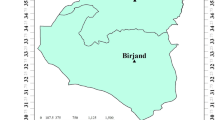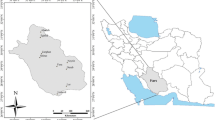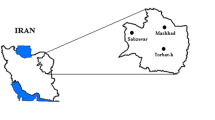Abstract
Water scarcity is the key challenge in arid regions, which exacerbates under climate change (CC) and must be considered to assess the impacts of CC on cropping systems. A climate-crop modeling approach was employed by using the CSM-CERES-Wheat model in some arid regions of northeast Iran to project the effects of CC on irrigated winter wheat production. Current climate data for 1990–2019 and climate projections of three climate models for the near-future climate period of 2021–2050 under RCP4.5 and RCP8.5 emission scenarios were used to run the crop model. Two irrigation scenarios with different irrigation efficiencies were also simulated to investigate the impacts of water scarcity associated with changing climate and irrigation management on winter wheat productivity. Results indicated that mean temperature is projected to increase in the range of 1.74–2.73 °C during the reproductive growth period of winter wheat over the study areas. The precipitation projections also indicated that the precipitation rates would decrease over most of the wheat-growing period. The length of the vegetative growth period will extend in some regions and shorten in others under the near future climate period due to a cooling and warming trend, respectively. However, the grain filling duration will be reduced by about 2–4 days across all regions. The mean seasonal potential evapotranspiration is expected to decrease by about 24 mm from 2021 to 2050 in Mashhad, Sabzevar, and Torbat-e Jam. A mean overall reduction in winter wheat yield due to future climate conditions would be about 12.3% across the study areas. However, an increase of 15–30% in the irrigation efficiency will be able to offset yield reductions associated with limited water supply under future climate scenarios. The results suggest that CC will exacerbate limited irrigation water resource availability, so implementing high-efficiency irrigation systems should be a priority to adapt to climate change in the arid cropping system of north-east of Iran.








Similar content being viewed by others
Data availability
All the data used for this study are available and provided by the corresponding author on reasonable request.
Code availability
DSSAT v4.7.
References
Agricultural Statistical Yearbook (2018) Ministry of agriculture Jihad. Agriculture Jahad publication, Iran.
Akbari M, Najafi Alamdarlo H, Mosavi SH (2020) The effects of climate change and groundwater salinity on farmers’ income risk. Ecol Indic 110:105893. https://doi.org/10.1016/j.ecolind.2019.105893
Allen RG, Pereira LS, Raes D, Smith M (1998) Crop evapotranspiration: Guidelines for computing crop water requirements. Irrigation and Drainage Paper No 56. Food and Agriculture Organization of the United Nations (FAO), Rome, Italy
Ashraf S, Nazemi A, AghaKouchak A (2021) Anthropogenic drought dominates groundwater depletion in Iran. Sci Rep 11:9135. https://doi.org/10.1038/s41598-021-88522-y
Bijl DL, Biemans H, Bogaart PW, Dekker SC, Doelman JC, Stehfest E, van Vuuren DP (2018) A global analysis of future water deficit based on different allocation mechanisms. Water Resour Res 54:5803–5824. https://doi.org/10.1029/2017WR021688
Bucchignani E, Mercogliano P, Panitz HJ, Montesarchio M (2018) Climate change projections for the Middle East-North Africa domain with COSMO-CLM at different spatial resolutions. Adv Clim Chang Res 9:66–80. https://doi.org/10.1016/j.accre.2018.01.004
Corwin DL (2021) Climate change impacts on soil salinity in agricultural areas. Eur J Soil Sci 72:842–862. https://doi.org/10.1111/ejss.13010
Dettori M, Cesaraccio C, Duce P (2017) Simulation of climate change impacts on production and phenology of durum wheat in Mediterranean environments using CERES-Wheat model. Field Crops Res 206:43–53. https://doi.org/10.1016/j.fcr.2017.02.013
Ding Z, Ali EF, Elmahdy AM, Ragab KE, Seleiman MF, Kheir AMS (2021) Modeling the combined impacts of deficit irrigation, rising temperature and compost application on wheat yield and water productivity. Agric Water Manag 244:106626. https://doi.org/10.1016/j.agwat.2020.106626
Djanaguiraman M, Boyle DL, Welti R, Jagadish SVK, Prasad PVV (2018) Decreased photosynthetic rate under high temperature in wheat is due to lipid desaturation, oxidation, acylation, and damage of organelles. BMC Plant Biol 18:55. https://doi.org/10.1186/s12870-018-1263-z
Doulabian S, Golian S, Toosi AS, Murphy C (2020) Evaluating the effects of climate change on precipitation and temperature for Iran using RCP scenarios. J Water Clim Chang 12:166–184. https://doi.org/10.2166/wcc.2020.114
El-Beltagy A, Madkour M (2012) Impact of climate change on arid lands agriculture. Agric Food Secur 1:3–14. https://doi.org/10.1186/2048-7010-1-3
Evans LT, Fischer RA (1999) Yield Potential: its definition measurement and significance. Crop Sci 39:1544–1551. https://doi.org/10.2135/cropsci1999.3961544x
Eyni-Nargeseh H, Deihimfard R, Rahimi-Moghaddam S, Mokhtassi-Bidgoli A (2020) Analysis of growth functions that can increase irrigated wheat yield under climate change. Meteorol Appl 27:1–10. https://doi.org/10.1002/met.1804
FAO (2003). Review of world water resources by country. Water reports 23. Rome, Italy. pp 3–7.
FAO/IIASA/ISRIC/ISS-CAS/JRC (2012) Harmonized World Soil Database (Version 1.2). FAO and IIASA, Rome, Italy and Laxenburg, Austria. http://webarchive.iiasa.ac.at/Research/LUC/External-World-soildatabase/HTML/index.html?sb=1. Accessed 02 December 2021
Farooq M, Bramley H, Siddique PJA, KHM, (2011) Heat stress in wheat during reproductive and grain-filling phases. Crit Rev Plant Sci 30:491–507. https://doi.org/10.1080/07352689.2011.615687
Farooq M, Hussain M, Siddique KHM (2014) Drought stress in wheat during flowering and grain-filling periods. Crit Rev Plant Sci 33:331–349. https://doi.org/10.1080/07352689.2014.875291
Frisvold G, Bai T (2016) Irrigation technology choice as adaptation to climate change in the Western United States. J Contemp Water Res Educ 158:62–77. https://doi.org/10.1111/j.1936-704x.2016.03219.x
Gebbing T, Schnyder H, Kuhbauch W (1999) The utilization of pre-anthesis reserves in grain filling of wheat: assessment by steady-state 13CO2/12CO2 labelling. Plant Cell Environ 22:851–858. https://doi.org/10.1046/j.1365-3040.1999.00436.x
Haghayeghi-Moghadam S A (2017). Agriculture water productivity improvement project in Khorasan Razavi province. Agricultural research, education and extension organization Press, Iran. pp 12–13. (in Persian)
Hawkins E, Sutton R (2011) The potential to narrow uncertainty in projections of regional precipitation change. Clim Dyn 37:407–418. https://doi.org/10.1007/s00382-010-0810-6
Hemming MN, Peacock WJ, Dennis ES, Trevaskis B (2008) Low-temperature and daylength cues are integrated to regulate FLOWERING LOCUS T in barley. Plant Physiol 147:355–366. https://doi.org/10.1104/pp.108.116418
Hernandez-Ochoa IM, Asseng S, Kassie BT, Xiong W, Robertson R, Luz Notelo Pequeno D, Sonder K, Reynolds M, Babar MA, Molero-Milan A, Hoogenboom G (2018) Climate change impact on Mexico wheat production. Agric for Meteorol 263:373–387. https://doi.org/10.1016/j.agrformet.2018.09.008
Hijioka Y, Lin E, Pereira JJ, Corlett RT, Cui X, Insarov GE, Lasco RD, Lindgren E, Surjan A (2014) Asia, In: Barros VR, Field CB, Dokken DJ, Mastrandrea MD, Mach KJ, Bilir TE, Chatterjee M, Ebi KL, Estrada YO, Genova RC, Girma B, Kissel ES, Levy AN, MacCracken S, Mastrandrea PR, White LL (Eds.), Climate change 2014: impacts, adaptation, and vulnerability. Part B: Regional Aspects. Contribution of Working Group II to the Fifth Assessment Report of the Intergovernmental Panel on Climate Change. Cambridge University Press, Cambridge, United Kingdom and New York, NY, USA, pp 1327–1370.
Hoogenboom G, Porter CH, Shelia V, Boote KJ, Singh U, White JW, Hunt LA, Ogoshi R, Lizaso JI, Koo J, Asseng S, Singels A, Moreno LP, Jones JW (2019) Decision Support System for Agrotechnology Transfer (DSSAT) Version 4.7.5 (https://DSSAT.net). DSSAT Foundation, Gainesville, Florida, USA.
IPCC (2014) Climate change 2014: synthesis report, In: Core Writing Team, Pachauri, R.K., Meyer, L.A. (Eds.), Contribution of Working Groups I, II and III to the Fifth Assessment Report of the Intergovernmental Panel on Climate Change. IPCC, Geneva, Switzerland.
IUSS Working Group WRB (2006) World reference base for soil resources 2006. World Soil Resources Reports No. 103. FAO, Rome.
Jafarnejad A, Sharif-Alhosseini M (2010) The responses of spring wheat cultivars to different planting dates in autumn in Neyshabur. Iran J Field Crops Res 8: 983–994. (in Persian with English summary) https://doi.org/10.22067/gsc.v8i6.8046.
Jafary F, Bradley C (2018) Groundwater irrigation management and the existing challenges from the farmers’ perspective in central Iran. Land 7:1–22. https://doi.org/10.3390/LAND7010015
Jamieson PD, Porter JR, Wilson DR (1991) A test of the computer-simulation model ARCHWHEAT1 on wheat crops grown in New Zealand. Field Crops Res 27:337–350. https://doi.org/10.1016/0378-4290(91)90040-3
Jiang T, Dou Z, Liu J, Gao Y, Malone RW, Chen S, Feng H, Yu Q, Xue G, He J (2020) Simulating the influences of soil water stress on leaf expansion and senescence of winter wheat. Agric for Meteorol 291:108061. https://doi.org/10.1016/j.agrformet.2020.108061
Jones PG, Thornton PK (2013) Generating downscaled weather data from a suite of climate models for agricultural modelling applications. Agric Syst 114:1–5. https://doi.org/10.1016/j.agsy.2012.08.002
Jones JW, Hoogenboom G, Porter CH, Boote KJ, Batchelor WD, Hunt L, Wilkens PW, Singh U, Gijsman AJ, Ritchie JT (2003) The DSSAT cropping system model. Eur J Agron 18:235–265. https://doi.org/10.1016/S1161-0301(02)00107-7
Karandish F, Kalanaki M, Saberali SF (2017) Projected impacts of global warming on cropping calendar and water requirement of maize in a humid climate. Arch Agron Soil Sci 63:1–13. https://doi.org/10.1080/03650340.2016.1177176
Karimi T, Stöckle CO, Higgins S, Nelson R (2018) Climate change and dryland wheat systems in the US Pacific Northwest. Agric Syst 159:144–156. https://doi.org/10.1016/j.agsy.2017.03.014
Keating BA, Meinke H, Probert ME, Huth NI, Hills IG (2001) NWheat: documentation and performance of a wheat module for APSIM. Tropical agriculture technical memorandum 9, CSIRO, Indooroopilly, Australia. https://doi.org/10.25919/g58j-5t69.
Kothari K, Ale S, Attia A, Rajan N, Xue Q, Munster CL (2019) Potential climate change adaptation strategies for winter wheat production in the Texas High Plains. Agric Water Manag 225:105764. https://doi.org/10.1016/j.agwat.2019.105764
Liu B, Liu L, Asseng S, Zou X, Li J, Cao W, Zhu Y (2016) Modelling the effects of heat stress on post-heading durations in wheat: a comparison of temperature response routines. Agric for Meteorol 222:45–58. https://doi.org/10.1016/j.agrformet.2016.03.006
Madani K, AghaKouchak A, Mirchi A (2016) Iran’s socioeconomic drought: challenges of a water-bankrupt nation. Iran Stud 49:997–1016. https://doi.org/10.1080/00210862.2016.1259286
Malash NM, Flowers TJ, Ragab R (2008) Effect of irrigation methods, management and salinity of irrigation water on tomato yield, soil moisture and salinity distribution. Irrig Sci 26:313–323. https://doi.org/10.1007/s00271-007-0095-7
Mesgaran MB, Madani K, Hashemi H, Azadi P (2017) Iran’s land suitability for agriculture. Sci Rep 7:7670. https://doi.org/10.1038/s41598-017-08066-y
Mishra A, Singh R, Raghuwanshi NS, Chatterjee C, Froebrich J (2013) Spatial variability of climate change impacts on yield of rice and wheat in the Indian Ganga Basin. Sci Total Environ 469:132–138. https://doi.org/10.1016/j.scitotenv.2013.05.080
NOAA National Centers for Environmental Information, State of the Climate: Global Climate Report for Annual 2020, published online January 2021. https://www.ncdc.noaa.gov/sotc/global/202013. Accessed 18 November 2021.
Nouri M, Homaee M, Bannayan M, Hoogenboom G (2017) Towards shifting planting date as an adaptation practice for rainfed wheat response to climate change. Agric Water Manag 186:108–119. https://doi.org/10.1016/j.agwat.2017.03.004
Reynolds MP, Saint Pierre C, Saad ASI, Vargas M, Condon AG (2007) Evaluating potential genetic gains in wheat associated with stress-adaptive trait expression in elite genetic resources under drought and heat stress. Crop Sci 47:172–189. https://doi.org/10.2135/cropsci2007.10.0022IPBS
Robertson GW (1968) A biometeorological time scale for a cereal crop involving day and night temperature and photoperiod. Int J Biometeorol 12:191–223. https://doi.org/10.1007/BF01553422
Robertson SM, Jeffrey SR, Unterschultz JR, Boxall PC (2013) Estimating yield response to temperature and identifying critical temperatures for annual crops in the Canadian prairie region Can J. Plant Sci 93:1237–1247. https://doi.org/10.4141/CJPS2013-125
Rosenzweig C, Tubiello FN (1996) Effects of changes in minimum and maximum temperature on wheat yields in the central US: a simulation study. Agric for Meteorol 80:215–230. https://doi.org/10.1016/0168-1923(95)02299-6
Saberali, SF, Nastari-Nasrabadi H, Dostkhah–Ahmadi M (2019) Investigating the impact of climate change on irrigated wheat production under Torbat-e Jam region for the near future. Iran J Field Crops Res. 17: 169–186. (in Persian with English summary) https://doi.org/10.22067/gsc.v17i1.74284.
Salem BB (1989) Arid zone forestry: a guide for field technicians. Food and Agriculture Organization (FAO) Conservation Guide 20. Rome, Italy.
Shewry PR (2009) Wheat J Exper Bot 60:1537–1553. https://doi.org/10.1093/jxb/erp058
Shirmohammadi-Aliakbarkhani Z, Saberali SF (2020) Evaluating of eight evapotranspiration estimation methods in arid regions of Iran. Agric Water Manag 239:106243. https://doi.org/10.1016/j.agwat.2020.106243
Shojaee T, Fallah-Ghalhari G (2017) Variations trend of climate parameters affecting on grape growth (Case study : Khorasan Razavi Province). Nat. Clim. Chang. 3: 45–58. https://doi.org/10.22059/jnec.2017.234944.68.
Smit B, Skinner MW (2002) Adaptation options in agriculture to climate change: a typology. Mitig Adapt Strateg Glob Change 7:85–114. https://doi.org/10.1023/A:1015862228270
Sommer R, Glazirina M, Yuldashev T, Otarov A, Ibraeva M, Martynova L, Bekenov M, Kholov B, Ibragimov N, Kobilov R, Karaev R, Sultonov M, Khasanova F, Esanbekov M, Mavlyanov D, Isaev F, Abdurahimov A, Ikramov R, Shezdyukova L, de Pauw E (2013) Impact of climate change on wheat productivity in Central Asia. Agric Ecosyst Environ 178:78–99. https://doi.org/10.1016/j.agee.2013.06.011
Ugarte C, Calderini DF, Slafer GA (2007) Grain weight and grain number responsiveness to pre-anthesis temperature in wheat barley and triticale. Field Crops Res 100:240–248. https://doi.org/10.1016/j.fcr.2006.07.010
Vaghefi SA, Keykhai M, Jahanbakhshi F, Sheikholeslami J, Ahmadi A, Yang H, Abbaspour KC (2019) The future of extreme climate in Iran. Sci Rep 9:1464. https://doi.org/10.1038/s41598-018-38071-8
Valizadeh J, Ziaei SM, Mazloumzadeh SM (2014) Assessing climate change impacts on wheat production (a case study). J Saudi Soc Agric Sci 13:107–115. https://doi.org/10.1016/j.jssas.2013.02.002
Vjaya Kumar P, Rro VUM, Bhavanli O, Dubey AP, Singh CB, Venkateswarlu B (2016) Sensitive growth stages and temperature thresholds in wheat (Triticum aestivum L.) for index-based crop insurance in the Indo-Gangetic Plains of India. J Agric Sci 154:321–333. https://doi.org/10.1017/S0021859615000209
White JW, Kimball BA, Wall GW, Ottman MJ (2012) Field crops research cardinal temperatures for wheat leaf appearance as assessed from varied sowing dates and infrared warming. Field Crops Res 137:213–220. https://doi.org/10.1016/j.fcr.2012.08.013
Whitfield DM, Smith CJ (1989) Effects of irrigation and nitrogen on growth, light interception and efficiency of light conversion in wheat. Field Crops Res 20:279–295. https://doi.org/10.1016/0378-4290(89)90071-3
Yin XY, Guo W, Spiertz JH (2009) A quantitative approach to characterize sink-source relationships during grain filling in contrasting wheat genotypes. Field Crops Res 114:119–126. https://doi.org/10.1016/j.fcr.2009.07.013
Zamanirad M, Sedghi H, Sarraf A, Saremi A, Rezaee P (2018) Potential impacts of climate change on groundwater levels on the Kerdi-Shirazi plain. Iran Environ Earth Sci 77:1–10. https://doi.org/10.1007/s12665-018-7585-1
Funding
This work has been financially supported by the vice-chancellor for research of the University of Torbat-e Jam.
Author information
Authors and Affiliations
Contributions
S. F. Saberali: conceptualization, methodology, model validation and evaluation, analyzed and interpreted the climate and crop data, and writing—original draft; Zahra Shirmohammadi-Aliakbarkhani and Hossein Nastari Nasrabadi: data preparation and curation, mapping and visualization, and writing—review and editing.
Corresponding author
Ethics declarations
Ethics approval
Not applicable.
Consent to participate
Not applicable.
Sse
Consent for publication
Not applicable.
Competing interests
The authors declare no competing interests.
Additional information
Publisher's note
Springer Nature remains neutral with regard to jurisdictional claims in published maps and institutional affiliations.
Rights and permissions
About this article
Cite this article
Saberali, S.F., Shirmohammadi-Aliakbarkhani, Z. & Nastari Nasrabadi, H. Simulating winter wheat production potential under near-future climate change in arid regions of northeast Iran. Theor Appl Climatol 148, 1217–1238 (2022). https://doi.org/10.1007/s00704-022-04005-8
Received:
Accepted:
Published:
Issue Date:
DOI: https://doi.org/10.1007/s00704-022-04005-8




